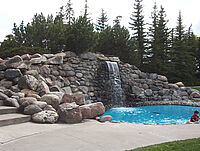In 1954, the Kiwanis Club of Regina submitted a plan to the Regina City Council to develop a large park on the edge of Wascana Creek at the corner of Regina Avenue and Elphinstone Street. This project, like Glen Harbour Camp, was a major one for the Club and is rightly considered by members to be of lasting benefit to the community. The park consists of an attractive sunken waterfall garden, large gardens and picnic areas, and Little League Baseball diamonds. The baseball diamonds were the first of their kind in Regina and they enabled National Little League Baseball to begin here.
A Leader-Post article (August 25, 1965) notes that the waterfall garden and larger garden areas were originally planned and developed by a retired prominent Regina florist and Kiwanis member, Frank Markham. The development of Kiwanis Park began in 1951, however, it appears that Markham had initiated the development of the gardens previous to this; but there are no records of a completed park. The extended Kiwanis Park area of sixteen and a half acres was made possible by the City's purchase [many years before] of 19 lots and 14 houses. Construction of the park, it was believed, would help solve the problem of annual spring flooding from Wascana Creek. The Club wanted the park to be "donated to the citizens of Regina" on the occasion of its fiftieth anniversary in 1969. The park was completed in 1963 and turned over to the City that year with an agreement that the the City would maintain the park, but the "future improvements to the park will be supported by the clubs" (Leader-Post, August 23, 1963).
The Kiwanis Club of Regina started the park project but the funding and development of the park became a joint project in later years when the Queen City, Wascana, and City Centre [Kiwanis] Clubs formed. Money for the project was raised through the annual Kiwanis Apple Campaign. Kiwanis members provided volunteer labour to construct the park. The Leader-Post called the park a "treasure for the City". The area, it said, had been transformed from "a quagmire into a beauty spot" (August 27, 1963). Only a few Kiwanis activities have taken place in the park but the public, one member has commented, uses it for "everything from picnics to weddings."
- quoted from The History of the Kiwanis Club of Regina 1919-1993
by Suzanne Stewart, August 6, 1993 prepared for the Club's 75th anniversary
Clarification provided by Dr. C.N. Bolen on January 4, 2005
The land upon which the Kiwanis Waterfall Park stands was reclaimed by the Kiwanis Clubs with the assistance of Kramer Tractor and Western Tractor which donated manpower and equipment for the extensive landfill. Design and engineering were donated by Kiwanians Frank Markham (florist) and Dan Stock (architect and engineer). The reclaimed low land had flooded every spring as far as Montague Street before the project was completed, restraining the creek within its course.
The Trans Canada Trail takes the traveller through Kiwanis Waterfall Garden along Wascana Creek and past the Kiwanis baseball diamonds.
Unveiling of Memorial - June 12, 2010

